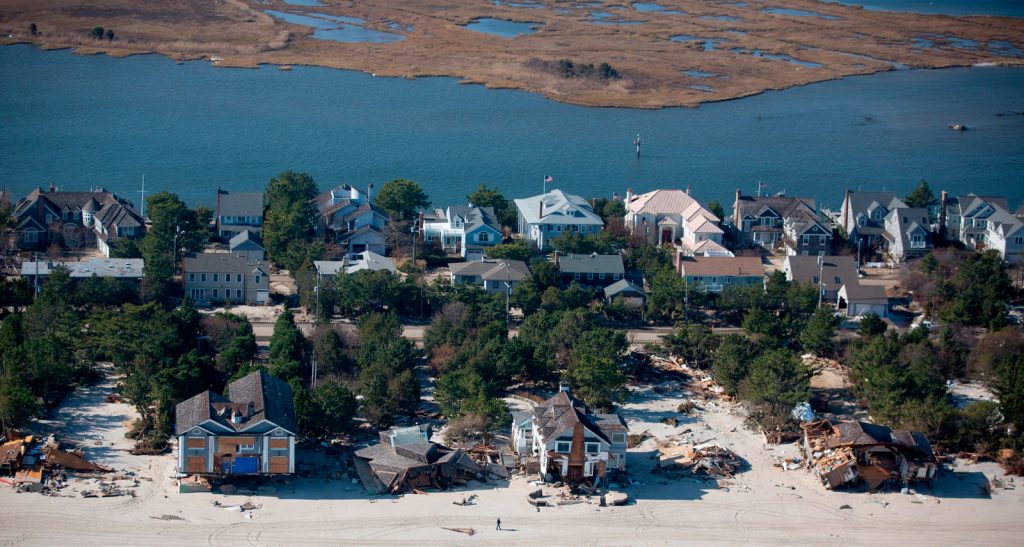Engineers, Ecologists and Risk Modelers Team Up to Measure the Value of Coastal Wetlands for Reducing Hurricane Risk
A new paper, The Value of Coastal Wetlands for Flood Damage Reduction in the Northeastern USA, published in Scientific Reports shows that coastal wetlands play a crucial role as a first line of defense from storm surges on the US Northeast coast.
This study, led by a team from the engineering, insurance and conservation sectors finds that coastal wetlands in the northeastern USA prevented more than US $625 Million in direct property damages during Hurricane Sandy, reducing damages by an average of 22% in over half the affected areas.
The Correlation Between Wetland Cover and Avoided Property Damages
In this study, we show a clear correlation between wetland cover and avoided property damages: the greater the extent of the wetland, the more protection it provides. Even relatively degraded wetlands in highly urban areas like New York City provided hundreds of millions of dollars in flood protection: during Hurricane Sandy, wetlands prevented US $140 million in flood damages in New York and $425 million in New Jersey.
Additionally, we measure the risk reduction benefits provided annually by marsh wetlands in Barnegat Bay in Ocean County, New Jersey. Using rigorous high-resolution flood and loss models, the study shows that the physical presence of wetlands in front of properties reduces their annual flood losses by an average of 16%, and up to a whopping 70% in some locations.
Every time the anniversary of a hurricane like Sandy, Katrina or Wilma comes around, one question we ask is: what have we learnt? The results of this study demonstrate convincingly, that conserving our coastal marshes has direct, quantifiable benefits to properties and infrastructure in terms of risk reduction. What’s more, these wetland benefits are measured using risk assessment methods and models widely used within the insurance industry.
Coastal wetlands prevented more than $625 Million (US) in direct property damages during Hurricane Sandy
The study also explores some of the factors that cause variation in the values of specific wetlands. For instance, townships at the upstream end of estuaries, like Hamilton township in New Jersey, greatly benefit from wetlands conserved several kilometers downstream. In other places, wetlands act like semi-permeable barriers, redirecting the surge around them such that areas directly behind them are protected, while areas in front of them see higher flooding.
Significance for Risk Reduction and Conservation Financing
The implications of these findings are significant, both for risk reduction practice as well as conservation financing. Increasingly, the economic benefits of natural habitats for risk reduction are being recognized not just by conservationists but by engineers, governments, and most recently, the private insurance sector. At present only 3% of public and private funding goes to restoring natural infrastructure (e.g., wetlands), while the rest goes to ‘grey’ infrastructure (e.g., concrete walls); this new paper makes a clear case for a reallocation of this coastal investment portfolio, particularly after disasters such as Hurricane Sandy.
In a connected report, within this project we identify how the findings in the Scientific Reports paper can be used to fund wetland conservation and restoration. This report also explores specific financial tools for investing in natural infrastructure to reduce current and future risks from flooding.
The risk reduction role of wetlands can be readily included in products of the risk and engineering sectors
For instance, before a disaster strikes, investments in habitat conservation that reduce coastal risk could reduce premiums on insurance and insurance linked securities (such as resilience bonds) – i.e. habitat restoration could pay for itself in savings. After a disaster strikes, private insurance and public recovery funds can support wetland conservation for future risk reduction, with the benefits of further reducing insurance premiums, and building coastal resilience against future disasters.
Quantifying the economic value of natural defenses will increase their relevance and inclusion in coastal management priorities. Although the risk reduction role of coastal wetlands is often implicitly included in risk models, it is not clearly recognized by risk modelers, (re)insurers, brokers, and clients.
This study shows that the risk reduction role of wetlands can be readily included in the products of the risk and engineering sectors, and thus more consistently considered in coastal development and habitat restoration decisions. In this, the risk and insurance industry can play a critical role in wetland restoration for coastal resilience and risk reduction.
Siddharth Narayan is a coastal engineer and the Lloyd’s-TNC Postdoctoral Fellow at the University of California Santa Cruz. Michael W. Beck is Lead Marine Scientist at The Nature Conservancy and Adjunct Professor at the University of California Santa Cruz.
Editor’s note: While there is much discussion of and interest in how people can better prepare for catastrophic events like the on-going disasters of Hurricane Harvey and the floods in Nepal, Bangladesh and India, rapid response and protection of life take precedence above all else right now. In the future, when communities are able to turn from response to recovery, we are hopeful that this kind of collaborative science will be a useful part of their healing and future planning.




Join the Discussion
3 comments